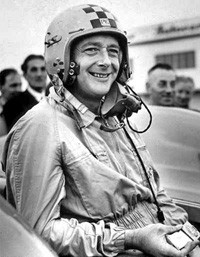
Donald Malcolm Campbell, was a British speed record breaker who broke eight absolute world speed records on water and on land in the 1950s and 1960s. He remains the only person to set both world land and water speed records in the same year (1964). He died during a water speed record attempt at Coniston Water in the Lake District, England.

Beaulieu is a village located on the southeastern edge of the New Forest in Hampshire, England. It is home to both Palace House and the National Motor Museum. In 2020, it was named the fifth most beautiful village in the UK and Ireland by Condé Nast Traveler.

The National Motor Museum is a museum in the village of Beaulieu, set in the heart of the New Forest, in the English county of Hampshire.

Major Sir Malcolm Campbell was a British racing motorist and motoring journalist. He gained the world speed record on land and on water at various times, using vehicles called Blue Bird, including a 1921 Grand Prix Sunbeam. His son, Donald Campbell, carried on the family tradition by holding both land speed and water speed records.

The Technik Museum Sinsheim is a technology museum in Sinsheim, Germany. Opened in 1981, it is run by a registered association called "Auto & Technik Museum Sinsheim e. V." which also runs the nearby Technik Museum Speyer.

Pendine Sands is a 7-mile (11 km) beach on the shores of Carmarthen Bay on the south coast of Wales. It stretches west to east from Gilman Point to Laugharne Sands. The village of Pendine is close to the western end of the beach.

The Royal Automobile Club is a British private social and athletic club. It has two clubhouses: one in London at 89 Pall Mall, and the other in the countryside at Woodcote Park, near Epsom in Surrey. Both provide accommodation and a range of dining and sporting facilities. The Royal Automobile Club has a wide range of members.

Reid Anthony Railton was a British automotive engineer, and designer of land and water speed record vehicles.

The Rolls-Royce R is a British aero engine that was designed and built specifically for air racing purposes by Rolls-Royce Limited. Nineteen R engines were assembled in a limited production run between 1929 and 1931. Developed from the Rolls-Royce Buzzard, it was a 37-litre capacity, supercharged V-12 capable of producing just under 2,800 horsepower (2,090 kW), and weighed 1,640 pounds (770 kg). Intensive factory testing revealed mechanical failures which were remedied by redesigning the components, greatly improving reliability.

Backbarrow is a village in the Lake District National Park in England. It lies on the River Leven about 5 miles (8 km) northeast of Ulverston in Furness in the county of Cumbria.

The Sunbeam 350HP is an aero-engined car built by the Sunbeam company in 1920, the first of several land speed record-breaking cars with aircraft engines.
The British land speed record is the fastest land speed achieved by a vehicle in the United Kingdom, as opposed to one on water or in the air. It is standardised as the speed over a course of fixed length, averaged over two runs in opposite directions.

Arthur Benjamins is a Dutch artist who has progressed from figurative motor sport paintings to Abstract Iconography, taking on the revival of Neoplasticism.

The Campbell-Railton Blue Bird was Sir Malcolm Campbell's final land speed record car.
Leopoldo Alfonso Villa was the long-serving mechanic of Sir Malcolm Campbell and Donald Campbell. He was born in London, of Italian and Scottish parents.

Blue Bird K4 was a powerboat commissioned in 1939 by Sir Malcolm Campbell, to rival the Americans' efforts in the fight for the world water speed record.

Kenelm Edward Lee Guinness MBE was an Irish racing driver of the 1910s and 1920s mostly associated with Sunbeam racing cars. He set a new Land Speed Record in 1922. Also an automotive engineer, he invented and manufactured the KLG spark plug. Additionally, aside from motorsport and mechanical interests, he was a director of the Guinness brewing company.

Blue Bird or Bluebird is the name of various cars and boats used by Sir Malcolm Campbell, his son Donald and other family members to set land and water speed records.

The Myreton Motor Museum is a museum located near the village of Aberlady, East Lothian, Scotland, which has a motoring history collection which covers most of the twentieth century.

The 1921 S.T.D. 'Works' Grand Prix chassis was built to the three-litre and minimum weight of 800 kilogrammes formula for that year's Indianapolis 500 and French Grand Prix de l’A.C.F. These team cars were modified by the Sunbeam Experimental department in Wolverhampton for the 1922 Isle of Man Tourist Trophy, which was won by one of the cars. A few months later, and with 1916 4.9-litre engines, two of the T.T. cars competed in the Coppa Florio, Sicily and gained second and fourth position.




















